Medical historians have devoted a lot of attention to homeopathy and its international dissemination. German physician Samuel Hahnemann initially described homeopathy in the 18th century. The term “homeopathy” is derived from the Greek words “homoeo” and “pathos,” and its history dates back to the time of Hypocrates.
Thought Behind the Big Discovery
Dr. Hahnemann discovered in one of his studies that the symptoms created by a substance might be cured by giving the same substance through a homeopathic preparation; the symptoms this material caused could also be healed with the same material in varying concentrations.
A medical professional with his own practice, Dr. Hahnemann was a physician. He objected to the harsh procedures of the day, such as bloodletting, purging, leeches, and the use of hazardous chemicals, and he was disenchanted by the way medicine was practiced and the way people were cured for their illnesses. He started his first homeopathic experiment in 1790. He discovered that the bark used in his experiment to alleviate the fever brought by malaria, gave him symptoms resembling malaria, and he came to the conclusion that if a small dose of a drug can cause symptoms in a healthy person, a tiny dose of the same thing can heal those identical symptoms in a person who are in need. Despite being hounded for his discoveries, he published his findings in scientific journals, and homeopathic medicine became more and more well-liked. Dr. Hahnemann created a homeopathic clinical practice while keeping thorough records of his discoveries and clinical trials. He was able to effectively heal people and introduced the idea of potentization. Dr. Hahnemann worked as a homeopath for 50 years until passing away in 1843.
The first homeopathic hospital opened its doors in 1832, and homeopathic medical schools sprung up all throughout Europe. Homeopathy had a significant impact on healthcare. As a result of the public’s recognition that homeopathic practitioners frequently achieved greater therapeutic outcomes than other prevalent methods, all practitioners were motivated to provide higher-quality care.
Homeopathy in Americas in the nineteenth century
Germ theory was still in its early stages and not fully understood at the time. The short explanation is that “normal” medicine was awful in the middle of the nineteenth century. Even those scholars who did postulate on the subject lacked any useful tools for applying it (no vaccinations, no antibiotics, etc.). Most “heroic” medical therapies used at the time included intense bloodletting, purges, and high doses of deadly amalgams of mercury or arsenic. Many common physicians still adhered to medical doctrines that originated in antiquity. In other words, being “not well” in the past was incredibly risky, extremely painful, and frequently fatal.
The use of modest doses, the emphasis on the healing power of nature, and the holistic approach to provide remedy to the body in homeopathy, on the other hand, made it a potential new advancement. It’s actually not difficult to comprehend why a mother would opt to administer a sick child a few little vials of a painless liquid as opposed to slicing their flesh to extract blood or giving them poison to cause severe vomiting. Homeopathy evolved into a profession that required its practitioners to observe the people who needed a cure, and this focus frequently developed a more empathetic relationship between practitioner and people who looked up to them to be cured.
Despite having its roots in Germany, homeopathy was already a thriving profession in the United States by the 1840s. Several alternative medical philosophies evolved during this time and Homeopathy emerged as most popular conventional medicine methodology.
Homeopathy in the Modern Age
A comprehensive approach to health and medicine is homeopathy. Although homeopathic principles and methods are also used in the curing and healing processes by other auxiliary health care practitioners. Canada now has various regions where homeopathic remedies are governed. The way that our contemporary civilization operates distances us from the ecosystem and from ourselves in ways that, upon closer examination, become harmful to our overall welfare on a number of levels. If we want to solve many of our concerns, both health-related and not, we should all embrace and support the broad homeopathic ethos about the need to get closer to nature and improve equilibrium.
Homeopathy is an advanced branch of medicine that customizes a material to a specific person depending on all of their symptoms. Whatever each symptom may be individually, they are all understood to be primarily an intrinsic effort on the part of the organism to respond to and adapt to a variety of internal or external stresses. The intrinsic ability of the body to defend and repair itself is compromised by methods that just suppress, control, or manage symptoms. For further details on how Homeopathy does not suppress symptoms and can be helpful in your specific case, please get in touch with us (The Healing Hands Homeopathy Clinic www.thehalinghands.ca). Homeopathic medicine is unsurprisingly growing in popularity at a time in our culture when it is crucial to create procedures that boost the immune and defense system.
Conclusion
The popularity of homeopathy in the twenty-first century is difficult to forecast, but it is likely that most practitioners will use at least part of the micro doses that research has shown to be efficient. More individuals will also learn how to self-prescribe homeopathic drugs for common acute ailments, and they’ll probably ask their care providers for homeopathic remedies for more serious health conditions.

